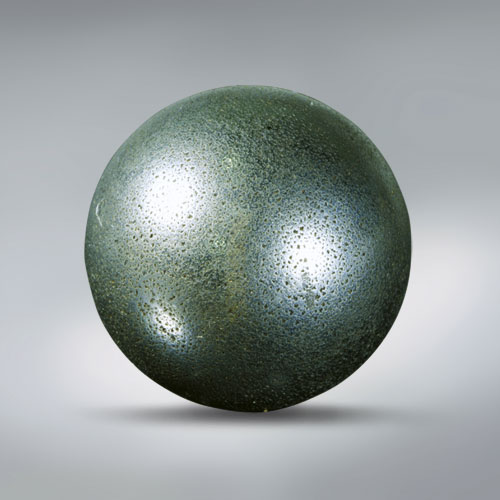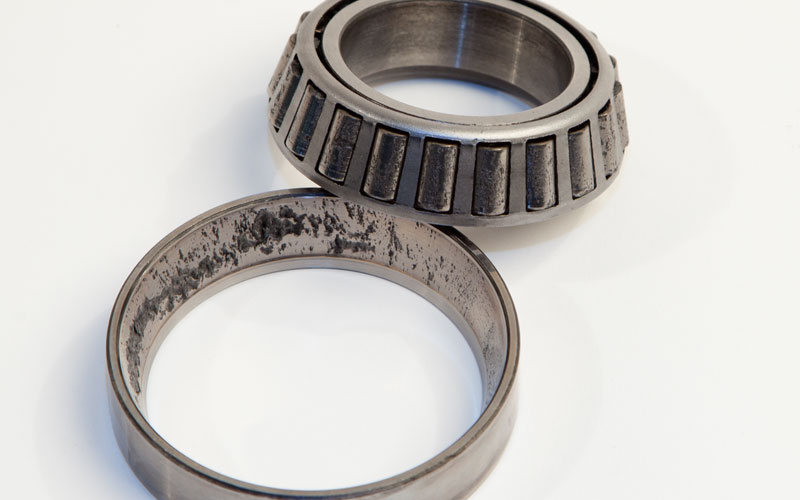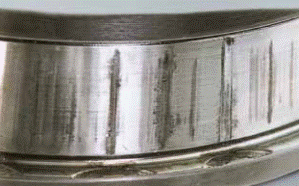Kye points :
-
Bearing is a mechanical element whose function is to support two machine parts and which permits relatve motion between them with minimum friction.
-
Bearings are classified on the basis of nature of contact as Sliding contact bearings and Rolling contact bearings.
-
Rolling contact bearings are further classified as Ball beaings and roller bearing.
-
Basic static load rating (C0) is the static radial load which the rolling bearing can bear, and it is equal to load which causes permenant deformation of 0.0001 times the diameter of the ball.
-
Stribeck devised an equation for the static capacity of ball and roller bearing.
-
Equivalent static load is defined as an imaginary static radial load which would produce the same total permenant deformation at the most heavily stressed ball and race contact as that would occur under the actual combined load conditions
-
The life of a bearing is defined as the total number of revolutions which the bearing can complete before the first evidentce of fatigue crack develpoed on the ball or roller or race.
-
The rating life of a group of apperently identical bearings is defined as the number of revolutions, which 90% of a group of bearing will complete or exceed before the firm evidence of crack.
-
Median or average life of a group of apparantely identical bearing is drfined as the number of revolutions which 50 %of a group of bearings will complete before the evidence of fatigue crack develops.
-
The basic dynamic load rating is defined as the constant radial load which a group of identical bearings can withstand for a rating life of one million (106) revolutions
Questions and Answers :
Q.1. Compare the Sliding contact bearing with Rolling contact bearing
Ans : Following table gives the requierd comparison
| Point | Rolling contact bearing | Sliding contact bearing |
|---|---|---|
| Load carrying element | Rolling element such as ball or roller carries the load | A film of lubricating oil takes the load from the shaft and transfers to the frame |
| Space requirement | More radial space is required to accomodate the bearing | Less radial space is required to accormodate the bearing |
| Friction | Lower frictional loss as compared to sliding contact bearing | More frictional loss as compared to the rolling contact bearing |
| Misalignment | Does not permit any slight mis-alignment . | It can accomodate slight misalignment in the shaft and bearing. |
| Reliability | Higher reliability since it does not depends on external factors. | Its reliability depends on many factors such as oil pressure, temperature and contamination of oil. |
Q.2. State the advantages and limitations of rolling contact bearings over sliding contact bearings.
Ans : Following are the some of the advantages of rolling contact bearings,
- Low starting torque
- Can support radial as well as axial loads
- Less sensitive to change in lubrication
- Low operating costs
- The bearing can be sealed with lubricant, which means life time lubrication is possible.
Limitations of rolling contact bearings
- More space is required in radial direction
- Higher initial cost
- Do not allow misalignment
- Fracture occurs due to fatigue cyclic loading
- Poor damping properties
- Noise level is higher in case of very high speeds.
Q.3. Write the note on 'Failure of rolling bearing'.
Ans : A rolling contact bearing fails either by breakage of parts like races and cage or the Surface destruction of the ball/roller or races. Mainly due to misalignment the load acting on some balls increses to a level that it crushes it resulting in failure.
In general following are the commonly types of failures of Roller bearing
1) Abrasive wear : This failure occurs due to dust ,rust and other foreign particles that enter in the bearing, it also occurs due to poor or lack of lubrication. Remedies against this type of wear are provision of oil seals, increasing surface hardness and use of high viscosity oils.When the lubricating oil is thick fine particles do not scratch the surface but remain in the film of lubricant.]
2) Corrosive wear : The corrosion of the surfaces of bearing parts is caused due to the entry of moisture or water in the bearing. Corrosion causes the rusting of the bearing surface resulting in fine wear of the surface. To avoid this type of failure the remedy is to provide the complete seal to the bearing.
3) Pitting : Pitting is the main cause of failure in rolling contact bearings. Pitting is nothing but the fatigue failure of the surface, which resutls in crack and subsequent pit on the surface of the bearing. Although this can not be avoided completed but limited by proper alignment and making the surface endurance strength high. A rolling element is said as 'Failed' when there is first sign of 'Pit' developed in the inner race or outer race or balls(rollers). Pitting is the local fracture of small area. It happens on ball/roller or the race as shown below



4) Scoring : Scoring is the scratching of the surface, which is caused due to excessive pressure and very high speed. Due to excessive heat the metal surface becomes soft and welding and shearing takes place at high spots. This mainly occurs due to very high temp of the bearing, and it can be avoided by properly selecting bearing and lubricant so that the temperature at the contacting surfaces remains within limits. Scoring is shown in image below.

Q.4. Define the following terms related to rolling bearing', 1) Rating life 2) Median life 3)Dynamic load carrying capacity 4)Load life relationship.
Q.5. Explain the procedure of selection of bearing from manufacturer's catalogue
Q.6. Explain the mounting of taper roller bearing with sketch. or Sketch Face to Face and Back to Back arrangement of taper roller bearing.
Q.7. What is preloading of rolling contact bearing? State and explain with sketch.
Q.8. Why ball and roller bearing are called 'Anti-friction bearing'.
Q.9. Where do you use self aligning ball bearing and spherical roller bearing.
Q.10. Where do you use proloaded rolling contact bearing?
Numerical Problems on Rolling Contact Bearings
1) A ball bearing is requiredtooperates on following work cycle:
Element No. Radial load (N) Speed (rpm) Element time (%)
1 3000 720 30
2 7000 1440 50
3 5000 900 20
The dynamic load capacity of the bearing is 16600N. Determine
i) Average speed of rotation.
ii) The equivalent radial load.
iii) Bearing life
2) A single row deep groove ball bearing is subjected to the following work
cycle which is given in table 1.
If the desired life of bearings is 8000 hours, select the bearing from the data
given in table 2

3) An electric motor 22 Kw power and running at 1440 rpm is coupled to a shaft of 25 mm diameter, which is supported by two cylindrical roller bearing . The shaft transmit power to another line shafte through a flat pulley having diamter 300 mm , which is placed midway between the two bearings. The coefficient of friction between the belt and pulley is 0.3 and angle of lap is 180 deg. the load factor is 1.5 and expected life of the bearing is 50000 Hours. Selectthebearing from the following table
4) A single row deep groove ball bearing is subjected to 20 second work cycle that consists of following two parts.

The static and dynamic load capacities of ball bearing are 50 and 60 kN respectively. Calculate the expected life of bearing in hours.

5) A shaft carries helical pinion at its center,is supported by deep groove ball bearing at ends. The center distance between the two bearings is 100mm. The shaft transmits 5kW power while running at 3000r.p.m. The pitch circle diameter of the pinion is 80 mm. The normal pressure angle and helix angle are 20° and 19°. Calculate the dynamic basis capacity of the bearing which takes up the axial thrust, so that it can be selected from the manufacture’s catalogue based on a reliability of 90%. Assuming, Shock load factor=1.25, Radial factor=0.56, Thrust factor=1.2

Where L, is life with reliability R and L 10 is rated life with reliability 90%.
6) A ball bearing operates with the following work cycle:

If the expected life of the bearing is 12000 hours with a reliability of 95%. calculate the basic dynamic load rating of the bearing so that it can be selected from the manufacturer’s catalogue based on 90% reliability.
 Where L, is life with reliability R and L 10 is rated life with reliability 90%.
Where L, is life with reliability R and L 10 is rated life with reliability 90%.
7) A shaft carries right handed helical pinion at its center is supported on two deep groove ball bearings at both ends. Centre distance between two bearings is 100 mm. Pinion is rotating in anticlockwise direction when viewed from right side of the pinion and is transmitting 5 kW power at 3000 rpm in horizontal direction. Pitch circle diameter of pinion is 80 mm. Normal pressure angle and helix angle are 20° and 19° respectively.
The required reliability of bearing is 95% with life 8,000 hours. Find dynamic load carry capacity of bearing to select it from
manufacturer’s Catalogue which is based on 90% reliability.Assume :
Shock factor (Ka) = 1.3,
Radial load factor (X) = 0.56
Thrust factor (Y) = 1.25
Use the relation 
8) Select a single row deep groove ball bearing with the operating cycle listed below, which will have a life of 15000 hours.
Assume radial and axial loads to be 1.0 and 1.5 respectively and inner race rotates.
Table for bearing selection
9) A transmission shaft is supported by two deep grove ball bearings at two ends. The centre distance between the bearings is 160 mm. A load
of 300 N acts vertically downwards at 60 mm distance from the left hand bearing whereas a load of 550 N acts horizontally at 50 mm distance
from right had bearing. Shaft speed is 3000 rpm and expected life of bearing is 7000 hours with a reliability of 95%. It is intended to use same bearing at both ends of the shaft. Calculate dynamic load rating of the bearing so that it can be selected from manufacturers catalogue.
10)An electric motor running at 1500 rpm is directly coupled to a shaft of 25 mm diameter, which is supported by two cylindrical roller bearings.
The shaft transmits power to another line shaft through flat pulley of 200 mm diameter, which is placed midway between two bearings. The tension on tight and slack side of belt is 4980 and 1660 N respectively. The belt is horizontal. The load factor is 1.4. If the expected life of the bearing is 10000 hours. Find the dynamic load carrying capacity of the bearing, so that bearing can be selected from the manufacturers catalog.
11)A shaft with centrally mounted helical pinion is supported by deep groove ball bearings at both ends. The centre distance between the bearings is 200 mm. the shaft transmits 5 kW power at 3000 r.p.m. The pitch circle diameter of the pinion is 80 mm. The normal pressure
angle and helix angle are 20° and 25° respectively. The expected life of the bearings is 10000 hours with a reliability of 95%. Calculate the dynamic load carrying capacity of the bearing which takes up the axial thrust so that it can be selected from the manufacturer’s catalogue based on the reliability of 90%.
- Log in to post comments




